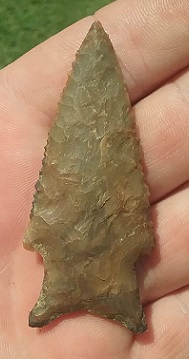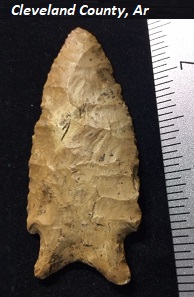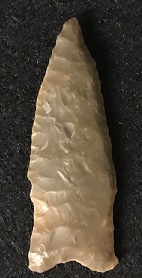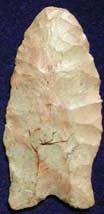Outline is Representative of Size and Shape:

Name Details:
Identified By: Edward G. Scully
Named For:
Date Identified: 1951
Type Site:
Identified By: Edward G. Scully
Named For:
Date Identified: 1951
Type Site:
Point Validity:
Valid type
Scully is a highly respected anthropologist from the University of Michigan who conducted extensive research in the Mississippi River valley and identified many different types of projectile points. This type was named in a professional publication and has many professional references. This is considered a valid type.
Scully is a highly respected anthropologist from the University of Michigan who conducted extensive research in the Mississippi River valley and identified many different types of projectile points. This type was named in a professional publication and has many professional references. This is considered a valid type.
Dalton Hemphill
Cluster: Dalton Cluster Description of Physical Characteristics and Flaking Pattern:
This is a
medium to large auriculate point. The cross section may range from elliptical to flattened. The blade is primarily
straight. The blade is commonly serrated and beveled. The waist is constricting which may create weak to absent
shoulders and articulates. Shoulders may vary from weak to horizontal or having an upward slope. The base may range
from slightly concave to deeply concave. Grinding is seen on the hafting area and basal grinding and flaking are common. Some basal flaking may give the appearance of fluting. The flaking pattern can vary from oblique transverse, horizontal transverse, collateral, or random.
Size Measurements:
Total Length - 33 to 88 mm (average 48 mm), Width - 21 mm average
Total Length - 33 to 88 mm (average 48 mm), Width - 21 mm average
Commonly Utilized Material:
Additional Comments:
This point evolved into the Hemphill point.
This point evolved into the Hemphill point.
Distribution: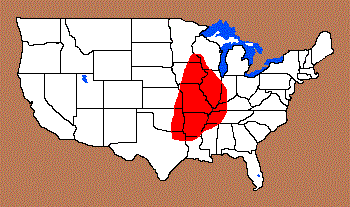
Distribution Comments:
This point is found through out the Mississippi River valley and into the Illinois River Valley and the Red River Valley.
This point is found through out the Mississippi River valley and into the Illinois River Valley and the Red River Valley.
Age / Periods:
Date: 10,000 - 8,500 B.P.
Cultural Period: Transitional Paleo
Glacial Period: Early Holocene
Culture:
Date: 10,000 - 8,500 B.P.
Cultural Period: Transitional Paleo
Glacial Period: Early Holocene
Culture:
Age Details:
Similar Points:
Arkabutla, Barnes, Candy Creek, Copena Articulated, Golondrina, Meserve, Nolichucky, Pelican, Plainview, San Patrice, Suwannee, Wheeler Recurve
Arkabutla, Barnes, Candy Creek, Copena Articulated, Golondrina, Meserve, Nolichucky, Pelican, Plainview, San Patrice, Suwannee, Wheeler Recurve
Other points in this cluster / Related / Associated Points:
Beaver Lake, Dalton, Dalton Breckenridge, Dalton Colbert, Dalton Greenbrier, Dalton Hempstead, Dalton Nuckolls, Dalton Sloan, Hardaway Dalton, Hi-Lo, Quad
Beaver Lake, Dalton, Dalton Breckenridge, Dalton Colbert, Dalton Greenbrier, Dalton Hempstead, Dalton Nuckolls, Dalton Sloan, Hardaway Dalton, Hi-Lo, Quad

